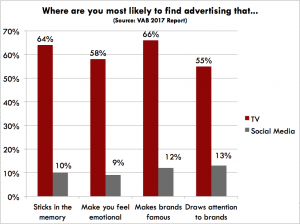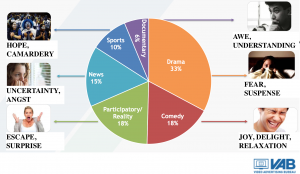TV’s enduring emotional edge vs social media
TV is still the media that best satisfies our human need for emotional connection, according to a fascinating Video Advertising Bureau (VAB) report: ‘Be Still My Viewing Heart’. Advertising on TV retains an important edge over social media in terms of building brand equity. “Emotionally compelling, character-driven premium programming fosters an ideal environment to showcase an advertiser’s brand,” says the report.

Below we look at some of the key reasons for TV’s enduring power as a brand building medium: time spent watching, entrainment value, emotional connection and urgency to view.
1. People spend MORE TIME watching TV
In the US people on average still spend 5+ hrs a day watching TV. This is double the time spent eating, drinking, shopping and viewing Facebook, combined.
“Ah yes. But Millennials don’t watch TV!”, I hear some readers protest.
Well, the data suggests they do.
Yes, people aged 18-34 do watch less TV: 3 hours a day. But this is still more time than spentEating/Drinking, Shopping, Using YouTube , Facebook And Instagram combined. 
2. TV is about being ENTERTAINED
The VAB report also sheds light on the ‘viewing mode’ we are in when consuming different media. This has important implications for advertising, as it sets the context in which people see your brand.
Watching TV is about being entertained, with 82% of people enjoying it for ‘pure entertainment’. This makes it the ideal place for brand-building communication that seeks to tell an emotionally compelling story. This is why most campaigns that have gained big online viewing numbers were ‘ignited’ during prime-time TV. For example, Always’ ‘Like a Girl’ campaign garnered 9.2 million social media ‘actions’, but was fuelled by a reported TV spend of $8.8million.
In contrast, we rely upon other media for “utility and functional benefits”:
- YouTube: mainly for music, which makes up 94% of the top 250 viewed videos. Plus quick-hit humor and ‘how-to’s’
- Twitter: Real-time news, which is the primary use for 86% of users
- Facebook: ‘making connections’ is the best thing that’s happened to 82% of users since joining, with only 10% citing ‘content’, such as news updates and stories
3. TV is more EMOTIONAL
TV has a range of genres, from comedy to drama, that provoke a whole range of different emotions. In contrast, YouTube is more mono-dimensional. As we saw earlier, music makes up 94% of the top 250 most viewed videos. And TV’s rich emotional content has a positive impact on advertising: six times more people agree that advertising on TV makes you feel emotional versus social media.

The emotional connection with TV programs is shown by the higher levels of social media consumption amongst Millennials:
- YouTube video content:
- Top 5 TV shows: 26 million
- Top 5 YouTube channels: 9 million
- Facebook followers:
- Top 5 TV shows: 92 million
- Top 5 YouTube channels: 43 million
Finally, the emotional connection with TV content is also long lasting: people talk about TV shows on and offline about before, during and after the program. And these hot shows are not all on Netflix as you might expect. 65% of Twitter’s top trending entertainment topics were driven by ‘advertiser-supported TV’, versus just 2% each for both Netflix and YouTube.
4. TV is about URGENCY
People feel a sense of urgency “to rejoin the stories we loyally follow”. This is why even in the US, where there is a high level of using PVRs (personal video recorders), 88% of primetime is viewed live. Only 12 % of primetime shows are watched in playback, a figure much lower than many of us in marketing might expect.
In conclusion, the VAB data shows TV retains an edge vs. social media both in terms of quantity of time spent consuming it, but also the quality of the media environment your brand is appearing in. Our enduring emotional connection with TV means it remains an important medium for brand building advertising.


